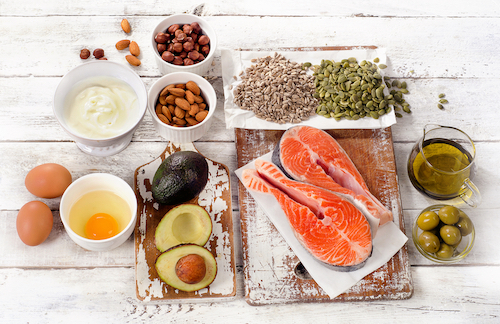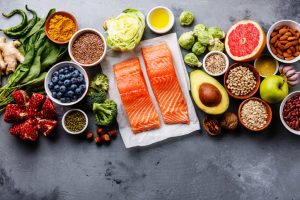What is fat?
There are three classes of nutrients; proteins, carbohydrates and fat, which is also known as lipid. Fat’s function is to provide energy for the body, and pound per pound it contains more energy in the form of calories than protein and carbohydrate. The three types of fat are triglycerides, cholesterol and phospholipids.
Fat calories are mostly stored in triglycerides. Fat does not just serve as an energy provider but fulfils other bodily functions – cholesterol and phospholipids are components of cell membranes and sheaths surrounding nerve cells, and cholesterol is also vital for the production of hormones (sex and adrenal hormones) as well as bile acids.
What are fatty acids?
Fatty acids are chains of carbon atoms linked by chemical bonds, with a methyl group at one end and a carboxyl group at the other. A methyl group is a cluster of carbon and hydrogen atoms, while a carboxyl group consists of carbon and hydrogen plus oxygen atoms. The chains come in different lengths, with short chain fatty acids having less than six carbons and long ones having 12 or more There are either single or double chemical bonds keeping the chain together – single bonds have more hydrogen molecules around them. These bonds determine whether a fatty acid is saturated or unsaturated.
Fatty acids provide energy to organs including the heart as well as muscles – they are also building blocks for cell membranes, and energy storage for the body. Fatty acids are converted into triglycerides if not used up as energy – these are molecules comprising three fatty acids with a glycerol compound ‘backbone’. They are stored in the body as adipose fat tissue.
What are saturated fatty acids?
Saturated fatty acids only have single chemical bonds, and fats containing them are known as saturated fats. These occur in high quantities in lard, butter, whole milk, cream, eggs, red meat, chocolate and solid shortenings. Too much saturated fat in your diet can raise cholesterol in the blood, as well as increasing the risk of coronary artery disease.
What are monounsaturated fatty acids?
Where saturated fatty acids have a single bond, monounsaturated fatty acids have a double bond. Monounsaturated fats are found in avocados, nuts and oils including olive, peanut and canola oil. It is believed by scientists that consuming a lot of monounsaturated fats helps to lower LDL cholesterol – ‘bad’ cholesterol – and lower the risk of coronary heart disease. This is especially the case when these fats are used in place of saturated fats and refined sugars.
What are polyunsaturated fatty acids?
Polyunsaturated fatty acids are distinguished by the fact that they have more than one double bond. You can find polyunsaturated fats in high quantities in vegetable oils, corn, soy and sunflower.
What are essential fatty acids?
Polyunsaturated fatty acids which the body cannot produce on its own but that it needs for metabolic function are known as essential fatty acids. It is necessary to eat foods containing essential fatty acids to maintain metabolic function.
What are omega-3 fatty acids?
Omega 3 fatty acids are found in many varieties of fish including salmon, halibut, sardines, albacore, trout, herring, shrimp, clams, tuna, catfish and cod. They are essential polyunsaturated fatty acids with a double bond in the third carbon position from the methyl terminal (chain end) – this position accounts for the ‘3’ in the description. You can also obtain Omega 3 from walnuts, flaxseed oil, canola oil and spinach.
What are omega-6 fatty acids?
As the name would suggest, Omega 6 fatty acids have a double bond in the sixth carbon position from the methyl group – they can be found in corn, safflower, sunflower, soybean and cottonseed oil.
What are the n-3 and n-6 fatty acids?
N3 is another name for Omega 3, while N6 is another name for Omega 6.
What are trans fatty acids?
Known as trans fats, trans fatty acids solidify liquid oils having been made through hydrogenation. If you heat an Omega 6 oil such as corn oil to a high temperature, trans fats are created. Trans fats increase the shelf life of oils and can be found in some margarines as well as vegetable shortenings, commercial pastries, fried foods, crackers, cookies and other snacks. Trans fats should not be consumed to excess as they increase ‘bad’ cholesterol or blood LDL cholesterol, while decreasing HDL or ‘good’ cholesterol and raising the risk of coronary heart disease.
Although it may not seem logical, fats are a necessary part of a healthy diet – it is important however to identify which fats are beneficial to health and which are detrimental to it. A good intake of the correct balance of omega3 to omega6 essential fatty acids is vital to keep the body healthy.
Do You Know Your Fats?

More from Diet & Weight LossMore posts in Diet & Weight Loss »




